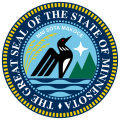November 5, 1912 | |||||||||||||||||||||||||||||||||||||
| |||||||||||||||||||||||||||||||||||||
 County results Burnquist: 30–40% 40–50% 50–60% 60–70% 70–80% Powers: 40–50% 50–60% Robertson: 40–50% Tie: 40–50% | |||||||||||||||||||||||||||||||||||||
| |||||||||||||||||||||||||||||||||||||
| Elections in Minnesota |
|---|
 |
The 1912 Minnesota lieutenant gubernatorial election took place on November 5, 1912. Republican Party of Minnesota candidate J. A. A. Burnquist defeated Minnesota Democratic Party challenger Winn Powers, Public Ownership Party candidate D. M. Robertson, and Prohibition Party candidate George H. Andrews.

